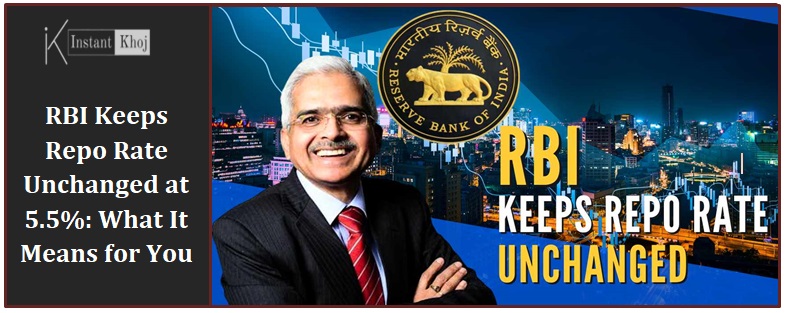Introduction: Why you should care (yes, you)
Picture this: you wake up tomorrow morning, check your bank statement, and your EMI hasn’t budged. Again. Frustrating, right? But hey — that’s exactly the consequence of what just happened: the RBI kept the repo rate unchanged at 5.5% for the second consecutive time.
Now before you groan, let me tell you: this isn’t just some dry policy number. The RBI repo rateaffects how much you pay for home loans, car loans, business credit — that “cost of money” in the system. When the central bank holds steady, it’s signaling something about the larger economy: inflation, growth, uncertainty.
So yeah, I get it — these things usually feel distant. But this move matters. And I’m going to walk you through what’s happening, why they did this, how it affects you, and what might come next (spoiler: there’s no one-size-fits-all answer). Let’s get into it.
The basics: What “repo rate unchanged at 5.5%” means
What is the repo rate, anyway?
Here’s the simple version: the repo rate is the interest rate at which the Reserve Bank of India lends short‑term funds to commercial banks (under something called the Liquidity Adjustment Facility, or LAF). When the repo rate goes down, borrowing gets cheaper; when it goes up, it gets more expensive.
So when people say “the RBI repo rate,” that’s shorthand for this central bank lever.
Why “unchanged” is a move, not a snooze
Some might see “no change” as no news. But in central banking, doing nothing is itself a statement. By holding the rate at 5.5%, the RBI (via its Monetary Policy Committee or MPC) is saying: “We’re watching, we’re cautious, growth and inflation both matter.”
This recent decision marks the second time in a row they’ve kept it unchanged. They paused after a series of earlier cuts in 2025. As of August, the panel had already reduced inflation projections, held a “neutral” stance, and waited for previous cuts to spread through the economy.
On October 1, 2025, the MPC reaffirmed that hold — keeping 5.5% intact.
Why they’re holding: Signals, risks, and trade‑offs
Here’s where it gets interesting.
Inflation is soft, but volatile
One of the reasons they feel “comfortable” holding is that inflation has cooled. In August, headline CPI inflation was notably low (around 2.1%) — a rare stretch of breathing room.
But let’s be real: food, fuel, global shocks can change that fast. So while headline numbers are favorable, core inflation and supply side risks keep the RBI on high alert. The latest forecasts suggest inflation for FY26 might be revised downward (to 2.6%) from earlier estimates.
Growth is holding — perhaps better than expected
Growth is another side of the coin. India’s first quarter growth was robust (around 7.8% in Q1 FY26). The RBI has raised its GDP forecast for FY26 from 6.5% to 6.8%.
They’re essentially betting: with inflation tame and growth decent, it’s better to pause and see how things unfold than rush into further cuts.
Global uncertainty and tariffs
Let me tell you — this is a wild card. Trade tensions (especially under the shadow of U.S. tariffs) are influencing the calculus. The RBI is cautious about weakening the rupee, capital outflows, or external shocks. Holding the repo rate gives them a buffer.
Also, they’ve reworked liquidity operations; they plan to manage system liquidity via 7-day operations (shifting from 14‑day ones) and aim to keep the overnight call rate close to the policy rate.
Transmission still playing out
Here’s the thing: when the RBI cuts rates, it doesn’t magically translate to lower loan rates overnight. Banks adjust gradually, lending spreads matter, and borrowers take time to respond. The MPC has explicitly said it wants to wait and watch how “frontloaded rate cuts” ripple through credit and demand.
So holding now gives space for past cuts to take root rather than overcorrecting.
Also Read:
CMF Headphones Pro Launched Globally, Set to Launch in India Soon
YouTube Premium Lite India Launch — Affordable Ad-Free Plan
Follow Blog’sonInstantkhoj for more latest stories and trending topics.
What this means for you (yes, your wallet)
Alright, let’s get practical.
For borrowers: EMIs, loans, mortgages
If you’ve taken a home loan, car loan, or business loan — and it’s linked to floating rates — you might have hoped for relief. But since the RBI held the repo rate steady, major shifts in your EMI are unlikely immediately.
Banks may adjust their internal lending rates eventually, but that depends on how competitive they want to be, margins, and liabilities.
For savers and depositors
If you’re a saver, this is less bad news: deposit rates won’t be slashed aggressively either. Banks won’t rush to cut what they pay you when their borrowing costs are stable.
For businesses and investors
If you’re running a business or planning expansion, this gives you some predictability. Credit costs stay stable for now. But if you were banking on further cuts to fuel your plan, you may need to temper expectations.
Investors will be watching bond yields, stock markets, forex — stability in rates could help reduce volatility. That said, yields spiked a little after the announcement (10‑year yields saw upward movement).
What to watch next (because this story isn’t over)
-
Next MPC meetings – The committee meets quarterly. Keep your eyes on data, commentary, and hints about future cuts or hikes.
-
Inflation trajectory – If inflation creeps up (via food or fuel), the RBI may have to reverse course.
-
Global developments – U.S. rate changes, trade wars, commodity prices — they all ripple to India.
-
Transmission – Watching how past cuts show up in lending rates, credit growth, consumer demand.
-
Foreign flows & rupee – If foreign investors pull out or rupee weakens, pressure mounts on monetary policy.
FAQ: Quick answers you actually want
Q1: What exactly is the RBI repo rate?
It’s the rate at which RBI lends short-term money to commercial banks. It’s a central tool of monetary policy and affects rates across the banking system.
Q2: Why didn’t RBI cut it this time?
Because inflation is under control, growth is holding, and they want time for previous rate cuts to take effect before making more moves.
Q3: Does this decision affect my home loan immediately?
Probably not. EMIs won’t change overnight. If your rate is floating, you might see adjustments later depending on your bank.
Q4: Could RBI raise rates soon?
Yes, but only if inflation surprises upward or global shocks demand a hawkish stance. Right now, they seem more cautious about cutting than raising.
Q5: What’s the growth forecast now?
They hiked the forecast to 6.8% for FY26 (from 6.5%).
Q6: And inflation projections?
They’ve trimmed inflation forecasts, possibly to about 2.6% for FY26.
Q7: How does this affect banks and profitability?
Banks may maintain margins; they’re less pressured to reduce lending rates or deposits because borrowing cost from RBI remains stable.
Q8: Will this decision hurt India’s competitiveness?
Not immediately — stability is sometimes better than sudden moves. But if global rates move aggressively, India may lose some flexibility.
Q9: When might the next repo cut happen?
If inflation stays low and growth slows, maybe late 2025. But that’s guessing. RBI has said they’ll closely monitor incoming data.
Q10: Should I delay taking a big loan hoping for lower rates?
That’s tricky. If you delay and rates rise or other costs increase, you might lose. If you move now with good terms, at least you lock something in.
The wrap (yeah, wrapping up)
So here’s where we stand: RBI keeps repo rate unchanged at 5.5% for the second time is not just a shrug — it’s a cautious, deliberate move. They’re riding the balance between inflation, growth, global shocks, and banking realities.
If inflation stays soft and credit picks up, maybe cuts come later. But if any storm clouds gather — whether from oil, trade, or currency — RBI has given itself room to respond without being boxed in.
Also Read:
CMF Headphones Pro Launched Globally, Set to Launch in India Soon
YouTube Premium Lite India Launch — Affordable Ad-Free Plan
Follow Blog’sonInstantkhoj for more latest stories and trending topics.




